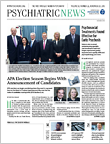In a study published October 13 in JAMA, researchers at the Substance Abuse and Mental Health Services Administration
(SAMHSA) and National Institute on Drug Abuse (NIDA) reported both good and bad news regarding prescription opioid use in the United States.
“Opioid use in this country has reached a level of public health significance,” Wilson Compton, M.D., M.P.E., deputy director of NIDA and a study coauthor, told Psychiatric News. “We have seen a marked increase in deaths related to prescription opioids over the past decade, and we’ve also seen a marked increase in heroin use, which we believe may be related to the prescription opioid problem.”
Heroin has been speculated by some addiction psychiatrists to be an alternative drug of choice for people who are addicted to prescription opioid-derived medications.
A previous report from SAMHSA estimated that rates of emergency department (ED) visits involving prescription opioids more than doubled from 2004 to 2011, from 82.5 per 100,000 ED visits to 184.1 per 100,000 ED visits. The Centers for Disease Control and Prevention reported that the prevalence of drug-poisoning deaths involving prescription opioids has more than tripled from 1998 to 2013, from 1.4 per 100,000 population to 5.1 per 100,000 population.
“Since illicit use of prescription opioid drugs has become an epidemic, we conducted the current study to have an updated summary of the prescription drug situation over the last 10 years, which is extraordinarily important for clinicians as well as policymakers,” said Compton.
For the study, whose first author was Beth Han, M.D., Ph.D., M.P.H., a statistician at the Center for Behavioral Health Statistics and Quality at SAMHSA, the prevalence of the nonmedical use of prescription opioids and prescription opioid use disorder (OUD) as well as mortality related to prescription opioid use were examined in U.S. adults aged 18 through 64. Datasets were generated from the 2003 to 2013 studies of the National Survey on Drug Use and Health (totaling 472,200 people) and the 2003 to 2013 reports of the Multiple Cause of Death Files from the National Vital Statistics System.
The analysis showed that the rate of nonmedical use of prescription opioids decreased from 5.4 percent in 2003 to 4.9 percent in 2013, but the prevalence of prescription OUD—in accordance with DSM-IV criteria—increased from 0.6 percent to 0.9 percent within that same period. The 12-month prevalence of high-frequency use (200 days or more) also increased from 2003 to 2013, from 0.3 percent to 0.4 percent.
Mortality assessed by drug overdose death rates involving prescription opioids increased from 4.5 per 100,000 in 2003 to 7.8 per 100,000 in 2013.
“The study’s findings are complex,” said Compton. “If we were just to look at the overall rates for opioid use, the findings would be considered great news; however, we see an increase in the intensity at which nonmedical users of prescription opioids use the drugs and the ramifications associated with illicit [prescription] opioid use, such as rates for opioid use disorder and mortality.”
Although Compton said that the reasons for the current rates associated with illicit opioid use are multifactorial, one area that must be addressed is prescription guidelines for chronic pain.
“These rates are highly related to access of prescription opioids and diversion of prescription opioids—with physicians being one of the primary sources of these pills,” Compton told Psychiatric News. “It’s important for us as physicians to ensure that these lifesaving medications are available to those who need the medicines, while ensuring that these drugs are not prescribed in excess amounts.”
In an accompanying editorial, Lewis Nelson, M.D., director of the fellowship in medical toxicology at New York University School of Medicine, and colleagues wrote that although much work is needed to decrease the prescription opioid use epidemic in this country, it is encouraging that the recent study shows a downward trend in the illicit use of prescription opioids. This is especially important “when considering the marketing of a plethora of new opioids for the treatment of chronic pain, none of which has been shown to be safe and effective over the long term. … Although multifaceted approaches are needed to successfully address the opioid epidemic, an important step is to start at the beginning and keep opioid-naive patients opioid naive.” ■
An abstract of “Nonmedical Prescription Opioid Use and Use Disorders Among Adults Aged 18 Through 64 Years in the United States, 2003-2013” can be accessed
here.

